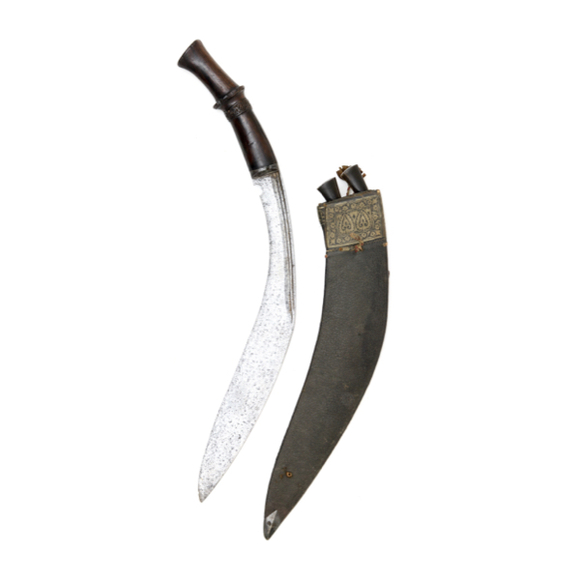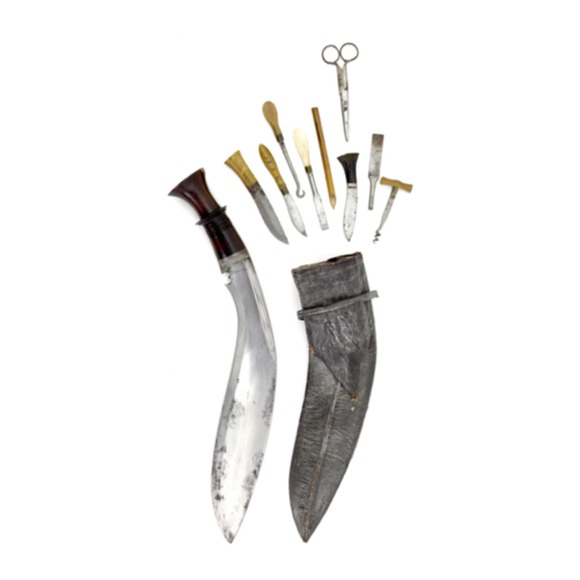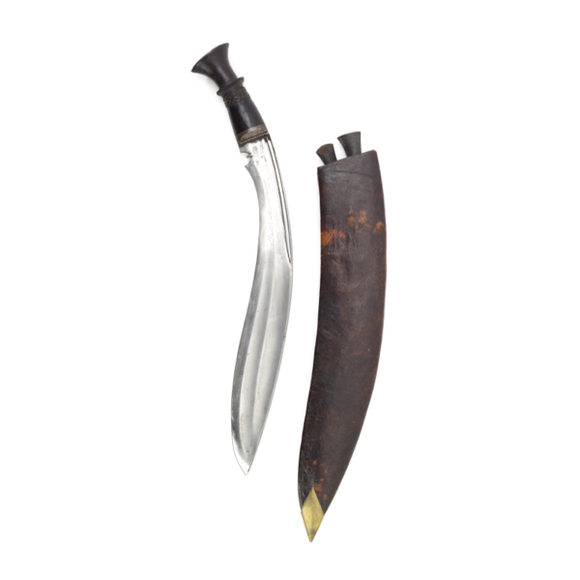Introduction
Tjikeroeh is an old writing for Cikeruh, a small village in the Sumedang Regency, West Java. The place was known for its arms production, which took place mostly between the 1850s and 1920s. They produced local goloks, parang, but also Dutch hunting knives and hybrid styles.
The arms produced there usually had markings at the base, often Tjikeroeh or abbreviations thereof like TJ.K.R. or TJI.K.R. and not infrequently a date. The blades were often made of good quality spring steel, but were forged without any pattern. Decoration usually consists of engravings on the blade, ranging in quality from coarse to rather fine.
In the literature
"Among the machetes and swords made in Preanger, those made by the gunsmith Natamadja in Tjikëroh, near the Pantjaekek railway stop, have acquired a certain fame. If we are not mistaken, the armament of the military police in Aceh is sourced from here. But Tjikëroeh has often been misused, especially in recent times, to sell inferior goods, possibly in that location, but still made by other smiths.
Anyone who has made the journey by rail through the Preanger will be able to testify that between Tjiandjoer and Tasikmalaja, sometimes at Soekaloemi, sometimes at Buitenzorg, peddlers pass by the passenger carriages at the stations and stops where the trains stop to greet the passengers, to offer for sale in a questionably colored hand or handkerchief machetes of all shapes and sizes in wooden sheaths and with wooden or horn handles."
My translation from:
H. C. H. de Bie; De landbouw der inlandsche bevolking op Java
Batavia, G. Kolff, 1901. Page 104.
In 1904, Tjikeroeh was mentioned as an important iron center where:
"lives a colony of arms smiths who uphold the historical good name
of the Padjadjaran arms smiths of old...
...they made beautiful Golok from f 2.50 to f 15,- which are in very high demand."
It further mentions that:
"It cannot be denied that these reports about the technically advanced Javanese weapons forgeing are extremely scanty. A separate description of the company in a place like Tjikëroeh should certainly not be missing, where, of course, the klewang's of the Acehnese military police are now made, as the best proof of the virtue of the blades forged there!"
My translation from:
Gerrit Pieter Rouffaer & Charles Theodoor Deventer; De voornaamste industrieën der inlandsche bevolking van Java en Madoera.
M. Nijhoff, 1904. Page 107.
"Of the processing of non-precious metals, bladesmithing ranks highest in the Dutch East Indies. The pamor-worked krisses and lances of Javanese princes and important men, the chiseling of swords from Tjikeroeh (Preanger Regencies), the knifes decorated with handles of flamed wood from Benkoelen, the gold decorations on Acehnese rentjongs, the bead and wood-carved craftsmanship of Dayak mandaus in so many genres show the ways in which the native shows off his state weapons."
My translation from:
H. Colijn (editor); Neerlands Indië, land en volk, geschiedenis en bestuur, bedrijf en samenleving. Onder leiding van H. Colijn. Amsterdam, Elsevier. 1911. Page 195.
Inzending van de Nederlandsch Indische Commassie voor de Wereldtentoonstelling te Brussel in IQIO, te Weltevreden (Batavia).
(Adviesnummer 55).
Wapens van Tjikéroeh
https://archive.org/details/UNIVERSITEITLEIDEN-DIG-459490/page/581/mode/2up?q=tjikeroeh

https://archive.org/details/encyclopaedievan0000twee/page/1524/mode/2up?q=tjikeroeh
http://www.vikingsword.com/vb/showthread.php?t=948&highlight=Tjikeroeh
The Cikeruh area in Jatinangor District, Sumedang Regency is currently known as a center for making air rifles. In fact, at the end of the 19th century and the beginning of the 20th century this area was known as the best Sundanese machete (bedog, bedhog) and sword maker in the Dutch colonial era.
In one of the Dutch records it is stated that in Cikeruh (Tjikeroeh), the southwestern part of Tanah Priangan on the island of Java, there is a machete, machete and sword maker with a unique, unique style named Nataatmadja. The location is not far from Rancaekek Train Station. (HCH De Bie, Batavia, G Kolff & Co., 1902).
Other Dutch records state that there were five (5) brothers and an indigenous man who became a blacksmith in Cikeruh. The most skilled among the five brothers was Kartaatmadja. Just like previous records, the location for making the machete is about 5 km from Rancaekek Station. (Algemeen Handlesblad van Vrijdag, Avondblad-Derde Blad, 16 October 1908).
The activities of the blacksmiths in Tjikeroeh were captured by a photographer from the Netherlands, Wijnand Elbert Kerkhoff under the title Wapensmederij (armourer) in a famous book "Het Paradijs van Java" or Heaven from Java, published between 1919-1930.
The same photographer, Wijnand Elbert Kerkhoff, also includes a photo of Soemadimadja's rifle factory in the book. Text attached to Geweermakerij (gun factory) photo. The note also stated that Soemadimadja was a gun repairman, a gun seller as well as a gun maker in the village of Tjikeroeh.
The tradition of making firearms in the Soemadimadja family started with his great-grandfather, Nataatmadja, who was also a blacksmith. And Nataatmadja has four (4) sons, Soeradimadja, Soemadimadja, Natadimadja and Tanoedimadja.
Switch professions naturally
The transition from making machetes, machetes and swords to making weapons began intensively after the death of Nataatmadja, a machete expert at Tjikeroeh. Weaponry technology is growing, especially the widespread use of rifles, causing orders for machetes, machetes and swords to decline, triggering a shift from the blacksmith profession to becoming an expert in making weapons.
If only now people were more familiar with the Cipacing area as "air rifle manufacture" (and apparently also the rifles known by the idiom 'assembly weapons from Cipacing'), it would turn out that they had learned from the gun makers in Tjikeroeh. Even in the 1960s, when the DI/TII (Darul Islam/Tentara Islam Indonesia) rebellion broke out in the West Java region, these Cikeruh weapons craftsmen were also flooded with orders for weapons from the Indonesian National Army (TNI), which was quelling the rebellion. .
The image of the Tjikeroeh Golok that I photographed above is an artifact belonging to the Delft Museum which has been returned to Indonesia, and is currently on display at the National Museum of the Republic of Indonesia (Elephant Museum) in 2021. According to the text, the Tjikeroeh Golok was made before 1897. It was purchased by the Museum Delft in the Netherlands from Jan Herman Beltman and is now in the collection of the Elephant Museum in Jakarta with No Inv S 451-2467. The hilt of the machete is made of wood and ivory.
There are two types of machetes made by the Tjikeroeh blacksmiths. The one that is typical of Sunda, and which is influenced by Europe. The machete above, which uses the typical Tjikeroeh, Sumedangan gravier decoration, also has a touch of European and even Middle Eastern style.
Tjikeroeh's beautiful machetes became world famous after one of his blacksmiths, Kartadimadja, had the opportunity to be sent to an arms exhibition in France. Apart from Tjikeroeh, according to Albert G Van Zonneveld, an author of Traditional Weapons from the Indonesian Archipelago (Indonesian Archipelago), beautiful machette type weapons like this are also made in other areas of Sumedang, Bandung in the Priangan area, and also Cigasong (Cirebon area). and Pahang in Java.
King's Weapon
Golok or the local language Bedhog (bedog), according to the ancient Sundanese manuscript Sanghyang Siksa Kanda Ng Karesian (1518), Bedog is the king's weapon. The words Bedog or bedhog are not found in official languages such as ancient books or inscriptions, but they are very widely used in the language of the people.
There are various forms of bedog, if taken in outline there are four (4) main forms, namely:
Tonggong plate (straight back), tonggong benthic (slightly curved back), beuteung plate (sharp part, some call huntu, straight) and beuteung ngagayot (sharp curved part. While the others are variants of the main form.
The shape of the back is divided into three, namely: nonggong munding (shaped like a buffalo's back), nonggong kuya (like a turtle's back) and flat back, some of the back is given a jegongan (the end is given a boy, as if it was made sharp). This jegongan besides being a variation of the shape of the back but also has a practical function, namely to split old coconuts that have been peeled for the husk.
On the body of the bedog blade there are also those who use ruruncang (a notch extending towards the tip), this is not only a form of variation but there are also those who regard it as a way of blood when the bedog is used to slaughter large animals (goats, buffaloes or cows). The cross-section of the bedog blade is usually called beuteung siraru, taking the shape of the body or stomach of an animal called a laron. So that the bedog is comfortable to wear and safe when carried, it needs to be given handle (handles, guarantees, handles) and a scabbard (sarong). Perahpun has quite a lot of names and shapes including various ornate carvings, while the scabbards are more like bedogs.
Between bedog blades, handle and scabbards are a unified whole of the meaning of a bedog. In the area of Cibingbing District, Kuningan Regency, there is a tradition called bedog wali, that is, when giving gifts from the groom to the bride, one of the grooms must bring a bedog. Of course, the bedog that is brought is not a naked bedog (has not put handle on and does not use a scabbard), but a complete bedog, with handles and a sheath, of course also covered with a nice bedog. The goal is not only for practical purposes but also has a symbolic meaning, especially for the bride and groom, the word bedog is said to be dibebed (tied) so that
Ngajedog (silence). This implies for the bride and groom after marriage they must bind themselves, body and soul for one goal, namely the happiness of the world and the hereafter. Marriage is no different from the proverb of bedog manjing scabbard.
An immoral act when a married woman is still looking for another scabbard, the bedog blade is the man and the scabbard is the woman.
The Sundanese people are very closely related to their natural surroundings, and this is reflected in the names of the bedog and handle blades. Names based on plants or plant parts:
Blade:
Sintung Bening, Paut Nyere, Salam Nunggal, Jambe Sapasi, Bribe Iwung, Kembang kacang, Malapah Gedang, Janur, Gula Sabeulah, Beubeut Nyere, Sulangkar (Leea sambucina Willd).
handle:
Balingbing, Eluk Nails (ferns), Pendul, Flowers, Pieces of Kai, Sopak Lodong, Jejengkolan.
Names based on animals:
Blade :
Simeut Pelem, Tail Hole, Tambak(ang).
handle:
Buhaya, Ekek, Soang Ngejat, Jawer Hayam, Cinghol (Ucing Nonghol), Pingping Hayam, Kucuit, Simeut Bako, Meong, Monkey/Lutung, Lauk Cai, Sea Horse, Garuda, Mear, Moyan Langur, Kidang Feet.
Job-related bar names:
Pamilikan (pabilikan), Pamoroan, Pameuncitan or Pacutongan, Tapping, Nyacag Meat, Soto.
Blade name due to shape:
Betekok, Petok, Gayot, Bentelu.
There are still other names for blades such as Hambalan, Jonggol, Narimbang
For handle:
Puppet Arjuna, Kresna, Cepot, Semar… *
Jimmy S Harianto (06.08.2023)






